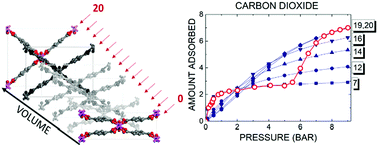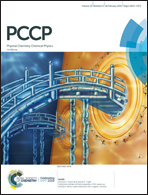Intermediate states approach for adsorption studies in flexible metal–organic frameworks†
Abstract
Adsorption studies in flexible metal–organic frameworks are challenging and time-consuming. It is mainly because the mechanism of adsorption, defined by structural framework properties, is constantly modified during the process, as the framework transformation depends on the adsorption uptake. We propose here a new approach to investigate adsorption in such complex systems, in which the simulations of adsorption in a deforming framework are replaced by the analysis of adsorption in intermediate rigid structures. As a proof of concept we analyze carbon dioxide, hexane, and methane adsorption in MIL-53. 19 intermediate structures were generated using geometrical interpolation between the open and the closed MOF forms and optimized with quantum DFT calculations. The grand canonical Monte Carlo method was applied to calculate adsorption isotherms in all intermediate structures. The comparison with experimental results enabled the identification of the intermediate adsorption states. The analysis of the microscopic configurations of the adsorbed molecules in these structures allowed us to propose a new mechanism of adsorbate evolution over the entire process.



 Please wait while we load your content...
Please wait while we load your content...